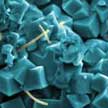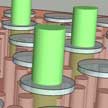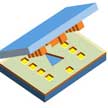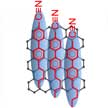Showing Spotlights 841 - 848 of 2878 in category All (newest first):
 The remarkable properties of some natural materials have motivated many researchers to synthesize biomimetic nanocomposites and other nanostructured materials that attempt to reproduce Nature's achievements. Recent research has indicated that the amplification of natural materials' mechanical properties far beyond those of the components that comprise them originates mainly from: 1) a hierarchical micro-/nanoscale architecture and 2) abundant effective interface interactions. A new progress report provides insight into the development of bio-inspired structural materials.
The remarkable properties of some natural materials have motivated many researchers to synthesize biomimetic nanocomposites and other nanostructured materials that attempt to reproduce Nature's achievements. Recent research has indicated that the amplification of natural materials' mechanical properties far beyond those of the components that comprise them originates mainly from: 1) a hierarchical micro-/nanoscale architecture and 2) abundant effective interface interactions. A new progress report provides insight into the development of bio-inspired structural materials.
Nov 10th, 2017
 Metal-organic frameworks (MOFs) are well-ordered, lattice-like crystals. The nodes of the lattices are metals, which are connected by organic molecules. Their size-controllable nanopores, special structure and large surface area make MOFs very attractive materials for next-generation, highly sensitive gas sensors. In new work, researchers demonstrate a process that can be used for developing low-cost and highly sensitive gas sensors. By increasing the sensitivity, the amount of gas sensitive material and device size can be reduced which in turn would reduce the overall cost of the device and energy consumption.
Metal-organic frameworks (MOFs) are well-ordered, lattice-like crystals. The nodes of the lattices are metals, which are connected by organic molecules. Their size-controllable nanopores, special structure and large surface area make MOFs very attractive materials for next-generation, highly sensitive gas sensors. In new work, researchers demonstrate a process that can be used for developing low-cost and highly sensitive gas sensors. By increasing the sensitivity, the amount of gas sensitive material and device size can be reduced which in turn would reduce the overall cost of the device and energy consumption.
Nov 7th, 2017
 The crucial roles of the physicochemical properties of cell culture substrates on function and behavior of a wide range of the cells are becoming well-studied in the current literature, using experimental approaches. However, development of in silico approaches for prediction of cell responses to the physicochemical properties of substrates is still in its infancy. In new work, an international team of researchers has developed a unifying computational framework to create a multi-component virtual cell model to probe cell function/behavior in silico.
The crucial roles of the physicochemical properties of cell culture substrates on function and behavior of a wide range of the cells are becoming well-studied in the current literature, using experimental approaches. However, development of in silico approaches for prediction of cell responses to the physicochemical properties of substrates is still in its infancy. In new work, an international team of researchers has developed a unifying computational framework to create a multi-component virtual cell model to probe cell function/behavior in silico.
Nov 1st, 2017
 Since the ground-breaking discovery of two-dimensional (2D) black phosphorus (phosphorene), it has created global research interest and triggered ripples of excitement in the scientific community due to its intriguing optical, mechanical and electronic properties. Researchers have looked into the state-of-the-art development of phosphorene, including its structure, preparation routes, anisotropic properties, device applications as well as the bottlenecks encountered by the research community. However, there still are quite a few obstacles and opportunities for scientists to tackle.
Since the ground-breaking discovery of two-dimensional (2D) black phosphorus (phosphorene), it has created global research interest and triggered ripples of excitement in the scientific community due to its intriguing optical, mechanical and electronic properties. Researchers have looked into the state-of-the-art development of phosphorene, including its structure, preparation routes, anisotropic properties, device applications as well as the bottlenecks encountered by the research community. However, there still are quite a few obstacles and opportunities for scientists to tackle.
Oct 31st, 2017
 Memristors present an opportunity to make new types of computers that are different from existing von Neumann architectures, which traditional computers are based upon. In new work, researchers have demonstrated the ability to reversibly control the learning properties of memristors via optical means. They show that light can be used in a reversible manner to change the connection strength (or conductivity) of artificial memristor synapses and as well control their ability to forget i.e. we can dynamically change device to have short-term or long-term memory. The reversibility is achieved by changing the polarization of light.
Memristors present an opportunity to make new types of computers that are different from existing von Neumann architectures, which traditional computers are based upon. In new work, researchers have demonstrated the ability to reversibly control the learning properties of memristors via optical means. They show that light can be used in a reversible manner to change the connection strength (or conductivity) of artificial memristor synapses and as well control their ability to forget i.e. we can dynamically change device to have short-term or long-term memory. The reversibility is achieved by changing the polarization of light.
Oct 30th, 2017
 Researchers have reported on improved performance of graphene-based moisture barrier layers. By combining catalytic CVD and ALD they created in scalable fashion nanolaminates of few-layer graphene and aluminium oxid. Unlike previous reports, this new approach exploits the synergy between different materials and growth techniques. These nanolaminates also are a potential material to be included in standard multi-stacked barrier layers to enhance the performance of existing ALD aluminium oxide and produce next generation moisture barriers.
Researchers have reported on improved performance of graphene-based moisture barrier layers. By combining catalytic CVD and ALD they created in scalable fashion nanolaminates of few-layer graphene and aluminium oxid. Unlike previous reports, this new approach exploits the synergy between different materials and growth techniques. These nanolaminates also are a potential material to be included in standard multi-stacked barrier layers to enhance the performance of existing ALD aluminium oxide and produce next generation moisture barriers.
Oct 26th, 2017
 Researchers demonstrate a novel assembly technique for transforming traditional state-of-the-art complementary metal oxide semiconductor (CMOS) based integrated circuits (IC) and other electronic components into LEGO-like modules by providing unique geometrical identity to each module; and assembling these 'LEGO IC' without the need for bonding or soldering but with the highest yield, accuracy and throughput required to maintain a high system performance.
Researchers demonstrate a novel assembly technique for transforming traditional state-of-the-art complementary metal oxide semiconductor (CMOS) based integrated circuits (IC) and other electronic components into LEGO-like modules by providing unique geometrical identity to each module; and assembling these 'LEGO IC' without the need for bonding or soldering but with the highest yield, accuracy and throughput required to maintain a high system performance.
Oct 25th, 2017
 Image sticking phenomena in liquid crystal (LC) devices became obvious soon after the production of the first nematic LC displays and have been a concern ever since. Now, researchers have developed a method to reduce the presence of excess ionic impurities by using a graphene electrode in the LC cell. Graphene shows high optical transmittance and high electrical conductivity, and therefore, graphene can be used as transparent electrodes.
Image sticking phenomena in liquid crystal (LC) devices became obvious soon after the production of the first nematic LC displays and have been a concern ever since. Now, researchers have developed a method to reduce the presence of excess ionic impurities by using a graphene electrode in the LC cell. Graphene shows high optical transmittance and high electrical conductivity, and therefore, graphene can be used as transparent electrodes.
Oct 24th, 2017
 The remarkable properties of some natural materials have motivated many researchers to synthesize biomimetic nanocomposites and other nanostructured materials that attempt to reproduce Nature's achievements. Recent research has indicated that the amplification of natural materials' mechanical properties far beyond those of the components that comprise them originates mainly from: 1) a hierarchical micro-/nanoscale architecture and 2) abundant effective interface interactions. A new progress report provides insight into the development of bio-inspired structural materials.
The remarkable properties of some natural materials have motivated many researchers to synthesize biomimetic nanocomposites and other nanostructured materials that attempt to reproduce Nature's achievements. Recent research has indicated that the amplification of natural materials' mechanical properties far beyond those of the components that comprise them originates mainly from: 1) a hierarchical micro-/nanoscale architecture and 2) abundant effective interface interactions. A new progress report provides insight into the development of bio-inspired structural materials.
 Subscribe to our Nanotechnology Spotlight feed
Subscribe to our Nanotechnology Spotlight feed





